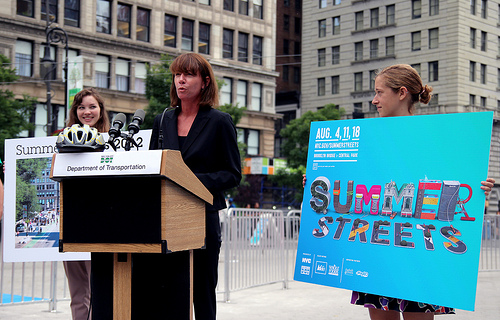Transportation safety under Bloomberg’s reign
As Mayor Michael Bloomberg’s epic 11-year-long reign over New York City draws to a close this fall, the politician-business magnate is fighting hard to pass a variety of reforms, from office buildings designed to fight obesity to improved gun control. Yet in the city whose drivers never sleep, one of Bloomberg’s key focuses has been on mitigating and managing traffic. How do his achievements stack up? Let’s look back on a few highlights:
The Weinshall Years, 2002-2007
After his 2002 swearing-in, Bloomberg re-appointed Iris Weinshall as Commissioner of the New York City Department of Transportation: one of the few appointments he had retained from prior mayor Rudy Giuliani’s staff.
A hallmark of Weinshall’s tenure: traffic management. Rocketing numbers for pedestrian fatalities and injuries along Queens Boulevard – and the negative press that followed – boosted the administration’s commitment to slowing traffic, adjusting the speed limit, adapting signal timing, installing pedestrian fencing and pedestrian refuges.

Soon-to-be-ex-Mayor Bloomberg. From Boss Tweed.
Another program, the THRU Streets 2003, aimed to ameliorate midtown traffic congestion by forbidding turns off certain streets between Third Ave. and Sixth Ave. Weinshall stepped down in 2007 and is currently CUNY’s Vice Chancellor for Facilities Planning, Construction and Management.
The Sadik-Khan Years, 2007-Present
Bloomberg replaced Weinshall with Janette Sadik-Khan, who remains in charge today and is perhaps best known for her commitment to bike lanes and pedestrian areas—as well as her occasionally divisive politicking.
Over the last six years, Sadik-Khan has focused on returning New York City back to its pedestrians, while Bloomberg has focused on financing the Number 7 subway West side expansion plan, backing congestion pricing south of 60th Street (despite its notable failure), and, some say, largely staying out of Sadik-Khan’s way. She’s transformed vehicle-dense sections of Broadway into cafe-esque, pedestrian-only rest areas, has overseen the installation hundreds of miles of bike lanes, and has removed hundreds of parking spots.
New bus rapid transit has also been pushed forward by Sadik-Khan, modeled after South American and European systems.

Outgoing NYC Department of Transportation head Janette Sadik-Khan. Courtesy NYCDOT.
Bloomberg has praised other developments, including installing speed cameras throughout the city to prevent injury and death, and, encouraged by his administration, the Citi Bike sharing program launched this year, has been called “the first new wide-scale public transportation option in more than half a century,” by the New York Times.
Bloomberg has enjoyed a relatively good safety record, as related to traffic (which happens to be where Commissioner Weinshall had focused most of her energy and where Commissioner Sadik-Khan continues to wield influence).
One apparent exception: Traffic fatalities between July 2011 through June 2012 were up 23% percent in the first increase since 2007, when there had been 310 traffic fatalities — the year Sadik-Khan took office. (Side note: a fascinating site offered through advocacy group Transportation Alternatives, Transalt.org offers a searchable database of cyclist accidents throughout NYC).
Traffic-related fatalities have dropped to historic lows under Bloomberg’s reign—although the number of drivers, passengers, cyclists and pedestrians killed in traffic deaths last year was more than those killed by guns.
What’s next?
This year’s mayoral candidates have a great deal to consider regarding the debate on transport under Bloomberg’s rule.
Would-be candidates John Liu and Joe Lhota have suggested removing some of the soon-to-be mayor’s bike lanes. Bill di Blasio is advocating for better “outer borough” transit and improved service to Hurricane Sandy-affected areas. Christine Quinn, a former proponent of congestion pricing, hasn’t made her current stance clear, though she does have a particularly Bloomberg-esque goal: to drop all New York City commutes to under 60 minutes.
Until the elections, Bloomberg himself will likely continue tackling transit issues at home, arguing for helmet use with the Citi Bike program, for one, and, as he suggested with his charity’s recent bike-helmet distribution event in Vietnam, taking the message abroad.
Category: Enforcement, Infrastructure, News & New Products, Pedestrian safety















